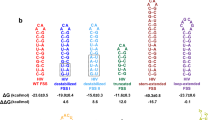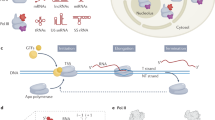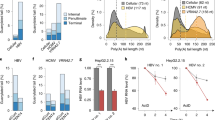Abstract
RNA helicase A (RHA) is a highly conserved DEAD-box protein that activates transcription, modulates RNA splicing and binds the nuclear pore complex. The life cycle of typical mRNA involves RNA processing and translation after ribosome scanning of a relatively unstructured 5′ untranslated region (UTR). The precursor RNAs of retroviruses and selected cellular genes harbor a complex 5′ UTR and use a yet-to-be-identified host post-transcriptional effector to stimulate efficient translation. Here we show that RHA recognizes a structured 5′-terminal post-transcriptional control element (PCE) of a retrovirus and the JUND growth-control gene. RHA interacts with PCE RNA in the nucleus and cytoplasm, facilitates polyribosome association and is necessary for its efficient translation. Our results reveal a previously unidentified role for RHA in translation and implicate RHA as an integrative effector in the continuum of gene expression from transcription to translation.
This is a preview of subscription content, access via your institution
Access options
Subscribe to this journal
Receive 12 print issues and online access
$189.00 per year
only $15.75 per issue
Buy this article
- Purchase on Springer Link
- Instant access to full article PDF
Prices may be subject to local taxes which are calculated during checkout








Similar content being viewed by others
Accession codes
Change history
14 May 2006
X-axis labeled incorrectly
Notes
* NOTE: In the version of this article initially published online, the label for the x-axis in Figure 5c was incorrect. This error was introduced during the production process for the article. The correct label should read "Time 3H metabolic labeling (min).” The error has been corrected for all versions of the article. We apologize for any inconvenience this may have caused.
References
Merrick, W.C. & Hershey, J.W.B. The pathway and mechanism of eukaryotic protein synthesis. in Translational Control (eds. Hershey, J.W.B., Mathews, D.H. & Sonenberg, N.) 31–69 (Cold Spring Harbor Laboratory Press, Plainview, New York, USA, 1996).
Kozak, M. An analysis of 5′-noncoding sequences from 699 vertebrate messenger RNAs. Nucleic Acids Res. 15, 8125–8148 (1987).
Ehrenfeld, E. Initiation of translation by picornavirus RNAs. in Translational Control (eds. Hershey, J.W.B., Mathews, M. & Sonenberg, N.) 549–573 (Cold Spring Harbor Laboratory Press, Plainview, New York, USA, 1996).
Wiegand, H.L., Lu, S. & Cullen, B.R. Exon junction complexes mediate the enhancing effect of splicing on mRNA expression. Proc. Natl. Acad. Sci. USA 100, 11327–11332 (2003).
Nott, A., Le Hir, H. & Moore, M.J. Splicing enhances translation in mammalian cells: an additional function of the exon junction complex. Genes Dev. 18, 210–222 (2004).
Gudikote, J.P., Imam, J.S., Garcia, R.F. & Wilkinson, M.F. RNA splicing promotes translation and RNA surveillance. Nat. Struct. Mol. Biol. 12, 801–809 (2005).
Short, J.D. & Pfarr, C.M. Translational regulation of the JunD messenger RNA. J. Biol. Chem. 277, 32697–32705 (2002).
Yilmaz, A., Bolinger, C. & Boris-Lawrie, K. Retrovirus translation initiation: issues and hypotheses derived from study of HIV-1. Curr. HIV Res. 3, 13 (2006).
Boris-Lawrie, K., Roberts, T.M. & Hull, S. Retroviral RNA elements integrate components of post-transcriptional gene expression. Life Sci. 69, 2697–2709 (2001).
Hull, S. & Boris-Lawrie, K. RU5 of Mason-Pfizer monkey virus 5′ long terminal repeat enhances cytoplasmic expression of human immunodeficiency virus type 1 gag-pol and nonviral reporter RNA. J. Virol. 76, 10211–10218 (2002).
Butsch, M., Hull, S., Wang, Y., Roberts, T.M. & Boris-Lawrie, K. The 5′ RNA terminus of spleen necrosis virus contains a novel posttranscriptional control element that facilitates human immunodeficiency virus Rev/RRE-independent Gag production. J. Virol. 73, 4847–4855 (1999).
Roberts, T.M. & Boris-Lawrie, K. The 5′ RNA terminus of spleen necrosis virus stimulates translation of nonviral mRNA. J. Virol. 74, 8111–8118 (2000).
Pelletier, J. & Sonenberg, N. Insertion mutagenesis to increase secondary structure within the 5′ noncoding region of a eukaryotic mRNA reduces translational efficiency. Cell 40, 515–526 (1985).
Miele, G., Mouland, A., Harrison, G.P., Cohen, E. & Lever, A.M. The human immunodeficiency virus type 1 5′ packaging signal structure affects translation but does not function as an internal ribosome entry site structure. J. Virol. 70, 944–951 (1996).
Roberts, T.M. & Boris-Lawrie, K. Primary sequence and secondary structure motifs in spleen necrosis virus RU5 confer translational utilization of unspliced human immunodeficiency virus type 1 reporter RNA. J. Virol. 77, 11973–11984 (2003).
Dangel, A.W., Hull, S., Roberts, T.M. & Boris-Lawrie, K. Nuclear interactions are necessary for translational enhancement by spleen necrosis virus RU5. J. Virol. 76, 3292–3300 (2002).
Zhang, S. & Grosse, F. Multiple functions of nuclear DNA helicase II (RNA helicase A) in nucleic acid metabolism. Acta Biochim. Biophys. Sin.(Shanghai) 36, 177–183 (2004).
Linder, P. Molecular biology. The life of RNA with proteins. Science 304, 694–695 (2004).
Nakajima, T. et al. RNA helicase A mediates association of CBP with RNA polymerase II. Cell 90, 1107–1112 (1997).
Anderson, S.F., Schlegel, B.P., Nakajima, T., Wolpin, E.S. & Parvin, J.D. BRCA1 protein is linked to the RNA polymerase II holoenzyme complex via RNA helicase A. Nat. Genet. 19, 254–256 (1998).
Aratani, S. et al. Dual roles of RNA helicase A in CREB-dependent transcription. Mol. Cell. Biol. 21, 4460–4469 (2001).
Fujii, R. et al. A role of RNA helicase A in cis-acting transactivation response element-mediated transcriptional regulation of human immunodeficiency virus type 1. J. Biol. Chem. 276, 5445–5451 (2001).
Kernan, M.J., Kuroda, M.I., Kreber, R., Baker, B.S. & Ganetzky, B. napts, a mutation affecting sodium channel activity in Drosophila, is an allele of mle, a regulator of X chromosome transcription. Cell 66, 949–959 (1991).
Kuroda, M.I., Kernan, M.J., Kreber, R., Ganetzky, B. & Baker, B.S. The maleless protein associates with the X chromosome to regulate dosage compensation in Drosophila. Cell 66, 935–947 (1991).
Li, J. et al. A role for RNA helicase A in post-transcriptional regulation of HIV type 1. Proc. Natl. Acad. Sci. USA 96, 709–714 (1999).
Gatfield, D. et al. The DExH/D box protein HEL/UAP56 is essential for mRNA nuclear export in Drosophila. Curr. Biol. 11, 1716–1721 (2001).
Kedersha, N. et al. Stress granules and processing bodies are dynamically linked sites of mRNP remodeling. J. Cell Biol. 169, 871–884 (2005).
Ryder, K., Lanahan, A., Perez-Albuerne, E. & Nathans, D. jun-D: a third member of the jun gene family. Proc. Natl. Acad. Sci. USA 86, 1500–1503 (1989).
van Dam, H. & Castellazzi, M. Distinct roles of Jun: Fos and Jun: ATF dimers in oncogenesis. Oncogene 20, 2453–2464 (2001).
Eferl, R. & Wagner, E.F. AP-1: a double-edged sword in tumorigenesis. Nat. Rev. Cancer 3, 859–868 (2003).
Ricci, R. et al. Distinct functions of junD in cardiac hypertrophy and heart failure. Genes Dev. 19, 208–213 (2005).
Braddock, M. et al. Intron-less RNA injected into the nucleus of Xenopus oocytes accesses a regulated translation control pathway. Nucleic Acids Res. 22, 5255–5264 (1994).
Matsumoto, K., Wassarman, K.M. & Wolffe, A.P. Nuclear history of a pre-mRNA determines the translational activity of cytoplasmic mRNA. EMBO J. 17, 2107–2121 (1998).
Kim, V.N., Kataoka, N. & Dreyfuss, G. Role of the nonsense-mediated decay factor hUpf3 in the splicing-dependent exon-exon junction complex. Science 293, 1832–1836 (2001).
Nott, A., Meislin, S.H. & Moore, M.J. A quantitative analysis of intron effects on mammalian gene expression. RNA 9, 607–617 (2003).
Lu, S. & Cullen, B.R. Analysis of the stimulatory effect of splicing on mRNA production and utilization in mammalian cells. RNA 9, 618–630 (2003).
Mangus, D.A., Evans, M.C. & Jacobson, A. Poly(A)-binding proteins: multifunctional scaffolds for the post-transcriptional control of gene expression. Genome Biol. 4, 223 (2003).
Isken, O. et al. Members of the NF90/NFAR protein group are involved in the life cycle of a positive-strand RNA virus. EMBO J. 22, 5655–5665 (2003).
Svitkin, Y.V. et al. The requirement for eukaryotic initiation factor 4A (elF4A) in translation is in direct proportion to the degree of mRNA 5′ secondary structure. RNA 7, 382–394 (2001).
Lee, C.G. & Hurwitz, J. A new RNA helicase isolated from HeLa cells that catalytically translocates in the 3′ to 5′ direction. J. Biol. Chem. 267, 4398–4407 (1992).
Moore, M.J. From birth to death: the complex lives of eukaryotic mRNAs. Science 309, 1514–1518 (2005).
Tseng, S.S. et al. Dbp5p, a cytosolic RNA helicase, is required for poly(A)+ RNA export. EMBO J. 17, 2651–2662 (1998).
Snay-Hodge, C.A., Colot, H.V., Goldstein, A.L. & Cole, C.N. Dbp5p/Rat8p is a yeast nuclear pore-associated DEAD-box protein essential for RNA export. EMBO J. 17, 2663–2676 (1998).
Chan, C.C. et al. eIF4A3 is a novel component of the exon junction complex. RNA 10, 200–209 (2004).
Ferraiuolo, M.A. et al. A nuclear translation-like factor eIF4AIII is recruited to the mRNA during splicing and functions in nonsense-mediated decay. Proc. Natl. Acad. Sci. USA 101, 4118–4123 (2004).
Chuang, R.Y., Weaver, P.L., Liu, Z. & Chang, T.H. Requirement of the DEAD-Box protein ded1p for messenger RNA translation. Science 275, 1468–1471 (1997).
Yedavalli, V.S., Neuveut, C., Chi, Y.H., Kleiman, L. & Jeang, K.T. Requirement of DDX3 DEAD box RNA helicase for HIV-1 Rev-RRE export function. Cell 119, 381–392 (2004).
Coller, J. & Parker, R. General translational repression by activators of mRNA decapping. Cell 122, 875–886 (2005).
Butsch, M. & Boris-Lawrie, K. Translation is not required to generate virion precursor RNA in human immunodeficiency virus type 1-infected T cells. J. Virol. 74, 11531–11537 (2000).
Hull, S. & Boris-Lawrie, K. Analysis of synergy between divergent simple retrovirus posttranscriptional control elements. Virology 317, 146–154 (2003).
Acknowledgements
We are grateful to K. Green-Church and the Ohio State University CCIC proteomics core for mass spectrophotometry, W.C. Merrick for valuable discussion, K. Hayes, I. Younis and members of the K.B.-L. laboratory for comments on the manuscript and T. Vojt for figure preparation. This work was supported by grants from the US National Institutes of Health (P01CA16058 and P30CA100730).
Author information
Authors and Affiliations
Corresponding author
Ethics declarations
Competing interests
The authors declare no competing financial interests.
Supplementary information
Supplementary Table 1
Oligonucleotide primers (PDF 46 kb)
Rights and permissions
About this article
Cite this article
Hartman, T., Qian, S., Bolinger, C. et al. RNA helicase A is necessary for translation of selected messenger RNAs. Nat Struct Mol Biol 13, 509–516 (2006). https://doi.org/10.1038/nsmb1092
Received:
Accepted:
Published:
Issue Date:
DOI: https://doi.org/10.1038/nsmb1092
This article is cited by
-
Blocking tri-methylguanosine synthase 1 (TGS1) stops anchorage-independent growth of canine sarcomas
Cancer Gene Therapy (2023)
-
LINC00460/DHX9/IGF2BP2 complex promotes colorectal cancer proliferation and metastasis by mediating HMGA1 mRNA stability depending on m6A modification
Journal of Experimental & Clinical Cancer Research (2021)
-
Identification of DHX9 as a cell cycle regulated nucleolar recruitment factor for CIZ1
Scientific Reports (2020)
-
RNA G-quadruplexes at upstream open reading frames cause DHX36- and DHX9-dependent translation of human mRNAs
Genome Biology (2018)
-
Dosage compensation and sex-specific epigenetic landscape of the X chromosome in the pea aphid
Epigenetics & Chromatin (2017)



